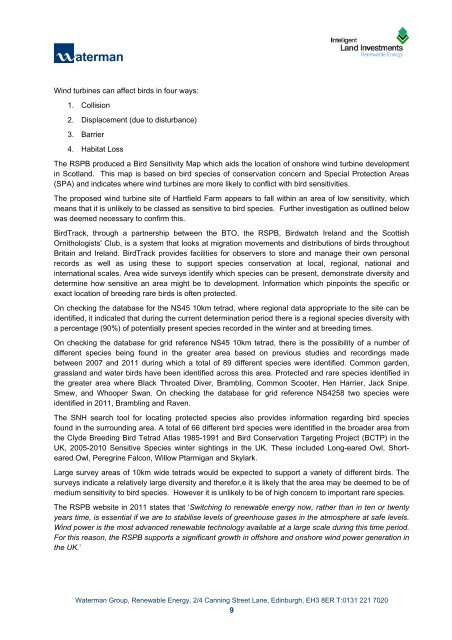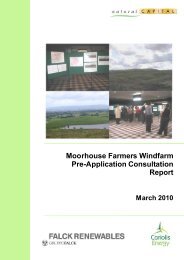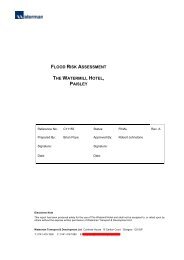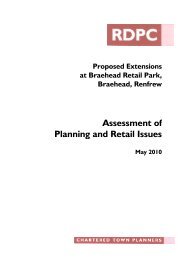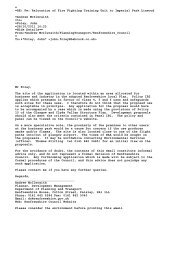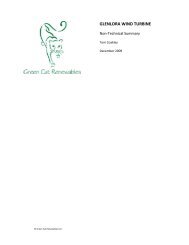Supporting Documentation - Renfrewshire Council
Supporting Documentation - Renfrewshire Council
Supporting Documentation - Renfrewshire Council
You also want an ePaper? Increase the reach of your titles
YUMPU automatically turns print PDFs into web optimized ePapers that Google loves.
Wind turbines can affect birds in four ways:<br />
1. Collision<br />
2. Displacement (due to disturbance)<br />
3. Barrier<br />
4. Habitat Loss<br />
The RSPB produced a Bird Sensitivity Map which aids the location of onshore wind turbine development<br />
in Scotland. This map is based on bird species of conservation concern and Special Protection Areas<br />
(SPA) and indicates where wind turbines are more likely to conflict with bird sensitivities.<br />
The proposed wind turbine site of Hartfield Farm appears to fall within an area of low sensitivity, which<br />
means that it is unlikely to be classed as sensitive to bird species. Further investigation as outlined below<br />
was deemed necessary to confirm this.<br />
BirdTrack, through a partnership between the BTO, the RSPB, Birdwatch Ireland and the Scottish<br />
Ornithologists' Club, is a system that looks at migration movements and distributions of birds throughout<br />
Britain and Ireland. BirdTrack provides facilities for observers to store and manage their own personal<br />
records as well as using these to support species conservation at local, regional, national and<br />
international scales. Area wide surveys identify which species can be present, demonstrate diversity and<br />
determine how sensitive an area might be to development. Information which pinpoints the specific or<br />
exact location of breeding rare birds is often protected.<br />
On checking the database for the NS45 10km tetrad, where regional data appropriate to the site can be<br />
identified, it indicated that during the current determination period there is a regional species diversity with<br />
a percentage (90%) of potentially present species recorded in the winter and at breeding times.<br />
On checking the database for grid reference NS45 10km tetrad, there is the possibility of a number of<br />
different species being found in the greater area based on previous studies and recordings made<br />
between 2007 and 2011 during which a total of 89 different species were identified. Common garden,<br />
grassland and water birds have been identified across this area. Protected and rare species identified in<br />
the greater area where Black Throated Diver, Brambling, Common Scooter, Hen Harrier, Jack Snipe,<br />
Smew, and Whooper Swan. On checking the database for grid reference NS4258 two species were<br />
identified in 2011, Brambling and Raven.<br />
The SNH search tool for locating protected species also provides information regarding bird species<br />
found in the surrounding area. A total of 66 different bird species were identified in the broader area from<br />
the Clyde Breeding Bird Tetrad Atlas 1985-1991 and Bird Conservation Targeting Project (BCTP) in the<br />
UK, 2005-2010 Sensitive Species winter sightings in the UK. These included Long-eared Owl, Short-<br />
eared Owl, Peregrine Falcon, Willow Ptarmigan and Skylark.<br />
Large survey areas of 10km wide tetrads would be expected to support a variety of different birds. The<br />
surveys indicate a relatively large diversity and therefor,e it is likely that the area may be deemed to be of<br />
medium sensitivity to bird species. However it is unlikely to be of high concern to important rare species.<br />
The RSPB website in 2011 states that ‘Switching to renewable energy now, rather than in ten or twenty<br />
years time, is essential if we are to stabilise levels of greenhouse gases in the atmosphere at safe levels.<br />
Wind power is the most advanced renewable technology available at a large scale during this time period.<br />
For this reason, the RSPB supports a significant growth in offshore and onshore wind power generation in<br />
the UK.’<br />
Waterman Group, Renewable Energy, 2/4 Canning Street Lane, Edinburgh, EH3 8ER T:0131 221 7020<br />
9<br />
K:\Projects\CIV12920_ILI Windfarms_Batch 7\CIV12920_XXX_Hartfield<br />
Farm\Documents\Reports\CIV12920_1202xx_Hartfield_<strong>Supporting</strong> Turbine Assessment_225kW.docx


